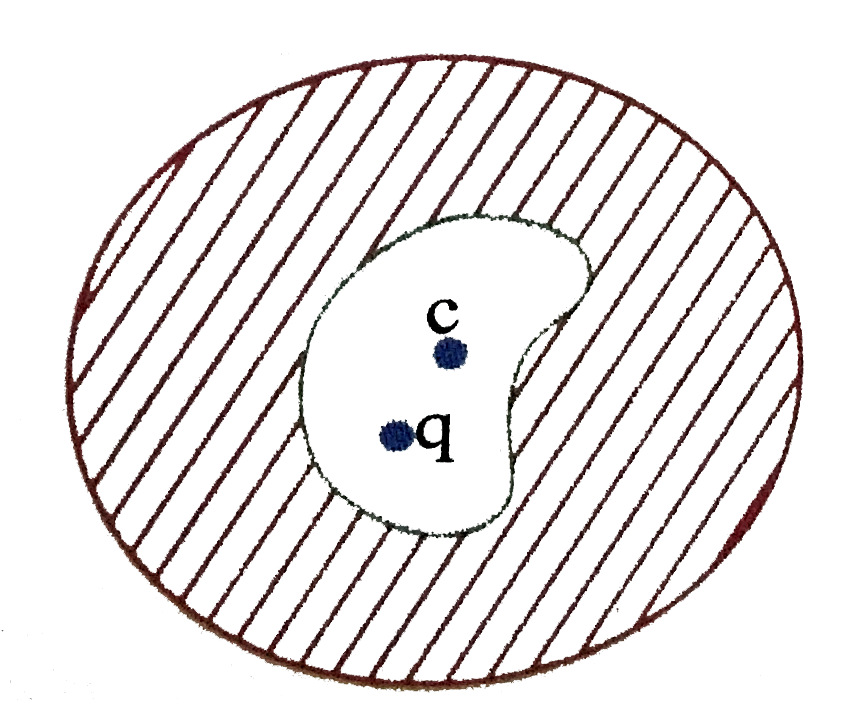A neutral spherical conductor has a cavity. A point charge q is located inside it. It is in equilibrium. An external electric field (E) is switched on that is directed parallel to the line joining the centre of the sphere to the point charge. (a) What is the direction of acceleration of the charge particle inside the cavity after E is switched on. (b) How is the induced charge on the wall of the cavity affected due to the external field.

The correct Answer is:(a). No acceleration
(b). Not affected.
Topper's Solved these Questions
- BOOK - ARIHANTCHAPTER - ELECTROSTATICSEXERCISE - Level 359videos
ELECTROSTATICS
- BOOK - ARIHANTCHAPTER - ELECTROSTATICSEXERCISE - Level 359videos
ELECTROSTATICS
- BOOK - ARIHANTCHAPTER - ELECTROMAGNETIC INDUCTIONEXERCISE - Level 312videos
ELECTROMAGNETIC INDUCTION
- BOOK - ARIHANTCHAPTER - GEOMETRICAL OPTICSEXERCISE - Level 39videos
GEOMETRICAL OPTICS
Similar Questions
A spherical metallic conductor has a spherical cavity. A positive charge is placed inside the cavity at its centre. Another positive charge is placed
View SolutionThe figure shows a charge q placed inside a cavity in an uncharged conductor. Now if an external electric field is swiched on
 View Solution
View Solution
Knowledge Check
- Question 1 - Select One
the figure shows a charge q placed inside a cavity in an uncharged conductor, Now if na external electric field is switched on
 AOnly induced charge on outer surface will redistributeBOnly induced charge on inner surface will redistributeCboth induced charge on outer and inner surface will redistributeDforce on charge q placed inside the cavity will change.
AOnly induced charge on outer surface will redistributeBOnly induced charge on inner surface will redistributeCboth induced charge on outer and inner surface will redistributeDforce on charge q placed inside the cavity will change. - Question 2 - Select One
A conductor with a cavity is charged positively and its surface charge density is σ. If E and V represent the electric field and potential, then inside the cavity
AE = 0 and V = 0BE = 0 and σ- constantCV = 0 and σ = constantDE = 0 and V = constant - Question 3 - Select One
A point charge q1 is placed inside cavity 1 and another point charge q2 is inside cavity 2. A point charge q is placed outside the conductor. For the situation described above, answer the following questions.
If charge q2 is at point Q (inside cavity 2), then →E at the center of cavity 2 due to induced charge on the surface of cavity 2 would beAq2/(4πε0r'22) toward q2Bq2/(4πε0r22) away from q2CzeroDcannot be determined
Two point charges +Q and -Q are separated by a certain distance. The resultant electric field is parallel to the line joining the charges at the points
View SolutionWe have a charged conductor having a cavity. Electric field inside the cavity is _________ and the electric potential inside the cavity is __________ .
View SolutionA conductor with a cavity is charged positively and its surface charge density is σ. If E and V represent the electric field and potential, then inside the cavity
View SolutionA point charge q1 is placed inside cavity 1 and another point charge q2 is inside cavity 2. A point charge q is placed outside the conductor. For the situation described above, answer the following questions.
If charge q2 is at point Q (inside cavity 2), then →E at the center of cavity 2 due to induced charge on the surface of cavity 2 would beView SolutionA charge q kept in front of a neutal metallic sphere. Find the electric field at the centre of sphere due to the induced charges on the surface of the sphere shown.
The net electric field inside the conductor is zero. This is produced by induced charged and the external charge.
 View Solution
View Solution
